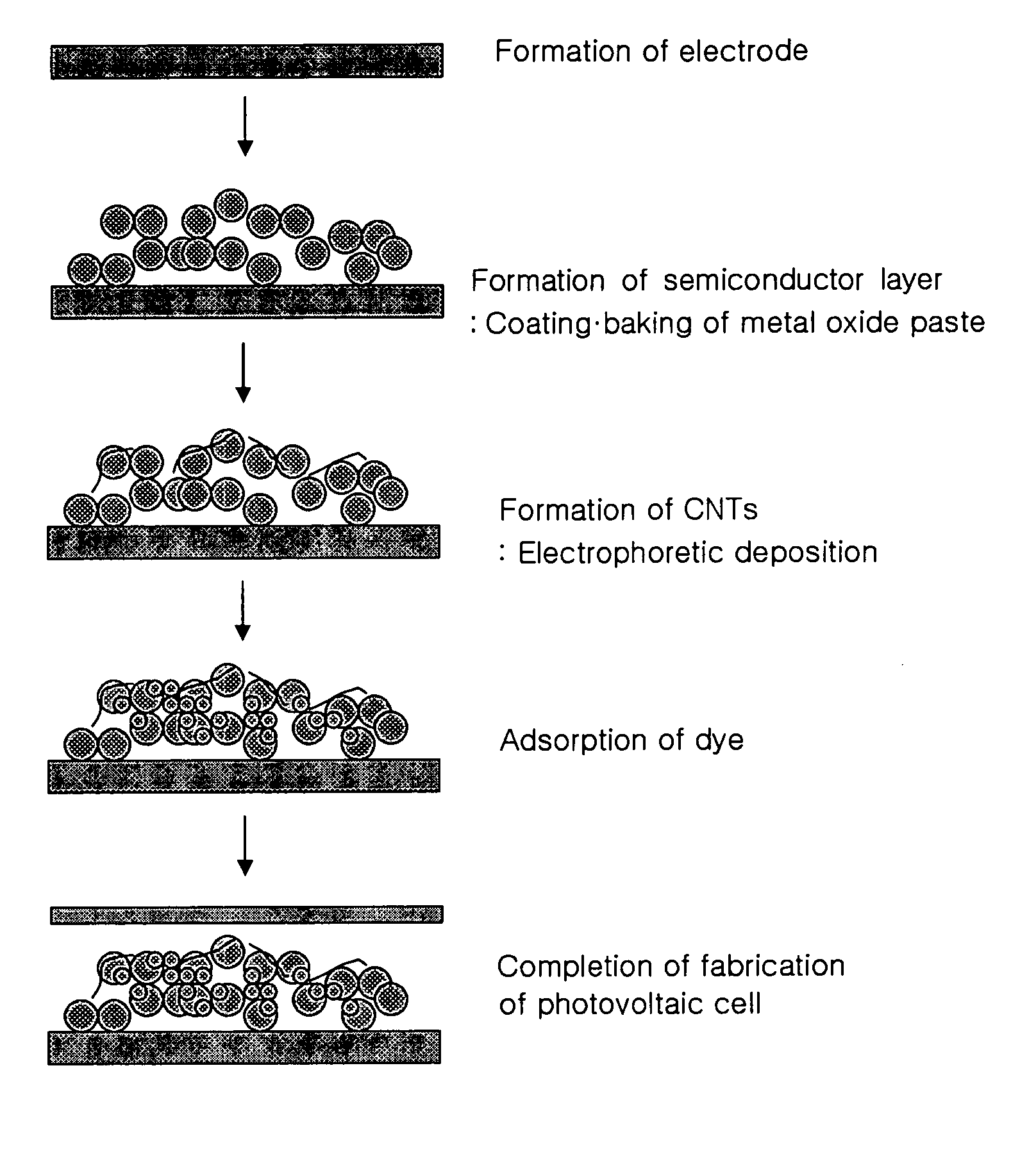Photovoltaic cell comprising carbon nanotubes formed by electrophoretic deposition and method for fabricating the same
a photovoltaic cell and carbon nanotube technology, applied in the field of photovoltaic cells, can solve the problems of reducing the power conversion efficiency, reducing the practical application and improvement of affecting the efficiency of silicon photovoltaic cells, so as to improve the electron transfer performance and increase the power conversion efficiency
- Summary
- Abstract
- Description
- Claims
- Application Information
AI Technical Summary
Benefits of technology
Problems solved by technology
Method used
Image
Examples
example 1
[0086] Fluorine-doped tin oxide (“FTO”) was applied to a glass substrate using a sputter, and then a paste of TiO2 particles having a particle diameter of 13 nm was applied thereto by screen printing. The resulting substrate was baked at 450° C. for 30 minutes to form a porous TiO2 film having a thickness of about 15 μm. Separately, carbon nanotubes were treated with HCl, HNO3, and the like, and dispersed in MgO.H2O for 0.5 hours to form an ionic state. The carbon nanotubes in an ionic state were attached to the TiO2 film by applying a voltage of 0.006 V / μm for 30 seconds in accordance with electrophoretic deposition. FIG. 8 is a scanning electron micrograph (“SEM”) showing the surface of the TiO2 layer on which the carbon nanotubes are deposited. Referring to FIG. 8, the carbon nanotubes are formed on the surface of the TiO2 layer. Subsequently, the resulting structure was dipped in a 0.3 mM ruthenium dithiocyanate 2,2′-bipyridyl-4,4′-dicarboxylate solution for 24 hours, and dried ...
example 2
[0088] A photovoltaic cell was fabricated in substantially the same manner as in Example 1, except that a TiO2 bilayer was formed by forming a 3 μm thick TiO2 layer using a paste of TiO2 particles having a diameter of 13 nm, and forming a 12 μm thick TiO2 layer thereon using a paste of TiO2 particles having a diameter of 300 nm. FIG. 9 is a cross-sectional scanning electron micrograph (“SEM”) of the photovoltaic cell.
example 3
[0089] A photovoltaic cell was fabricated in substantially the same manner as in Example 1, except that the electrophoretic deposition was performed by applying a voltage of 0.006 V / μm for 60 seconds to form a carbon nanotube layer.
PUM
| Property | Measurement | Unit |
|---|---|---|
| particle size | aaaaa | aaaaa |
| particle size | aaaaa | aaaaa |
| particle size | aaaaa | aaaaa |
Abstract
Description
Claims
Application Information
 Login to View More
Login to View More - R&D
- Intellectual Property
- Life Sciences
- Materials
- Tech Scout
- Unparalleled Data Quality
- Higher Quality Content
- 60% Fewer Hallucinations
Browse by: Latest US Patents, China's latest patents, Technical Efficacy Thesaurus, Application Domain, Technology Topic, Popular Technical Reports.
© 2025 PatSnap. All rights reserved.Legal|Privacy policy|Modern Slavery Act Transparency Statement|Sitemap|About US| Contact US: help@patsnap.com



